This article by Martin Smith and Tash Shifrin first appeared on Dream Deferred on 11 June 2018.
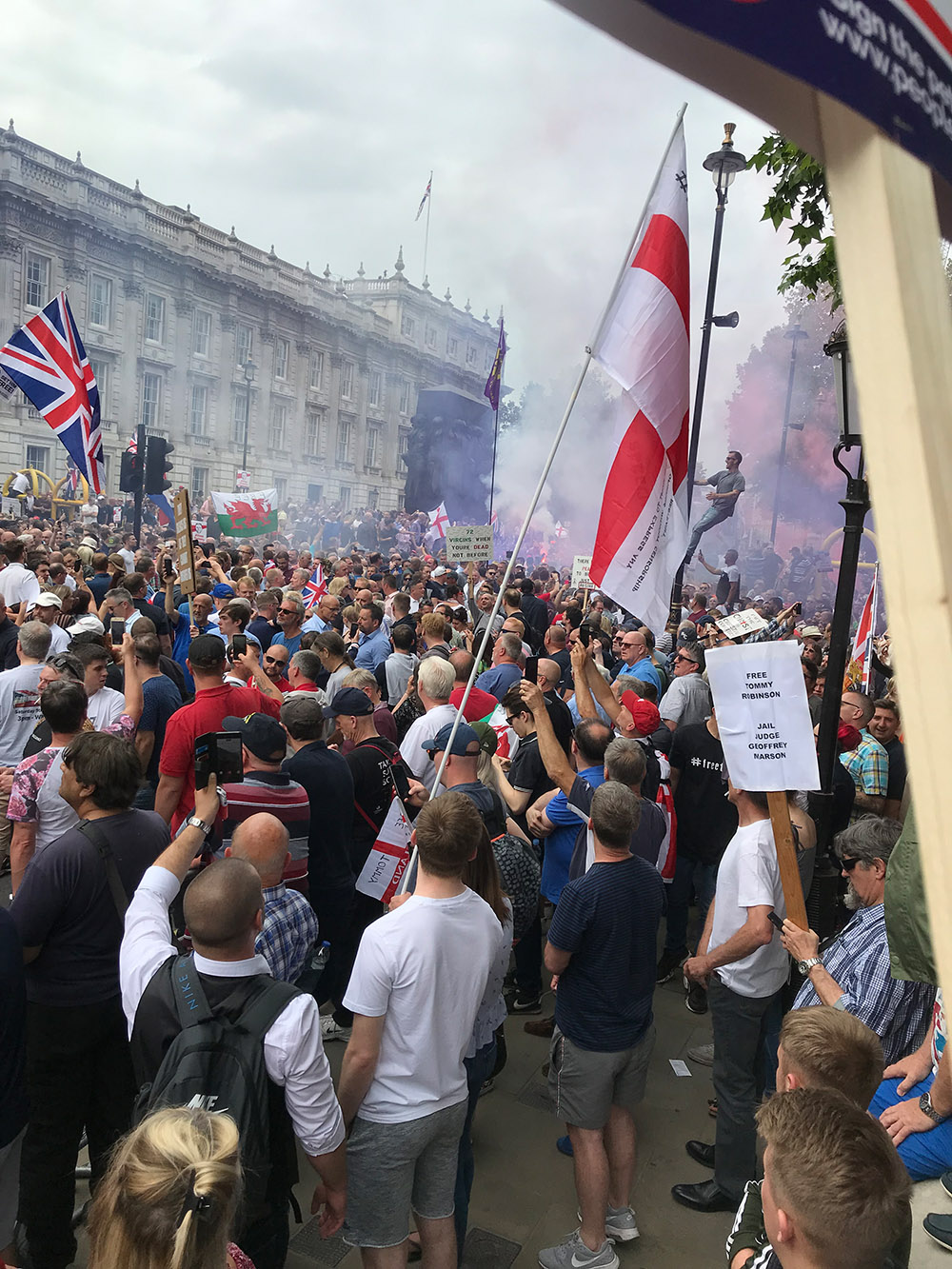
The far right in Britain has mobilised its biggest ever demonstration. Around 15,000 people joined the “Free Tommy Robinson” demo in Whitehall, central London on Saturday 9 June. We look here at what the march means in the context of the fast-developing new far right movement in Britain.
Saturday’s demo was far bigger than anything produced by the English Defence League (EDL) or by the National Front in the 1970s. Even Oswald Mosley’s British Union of Fascists was only able to stage events on this sort of scale indoors.
It came just a month after 5,000 turned out for the “Day for Freedom” protest called by Robinson, also in Whitehall, a professionally produced rally which we argued marked a turning point for fascists and the far right in Britain.
And in the run-up to Saturday’s huge turn-out of racists and fascists, we saw three major far right mobilisations in the space of a week, in a sudden speed-up of the far right street movement.
The 9 June demonstration called for the release of Tommy Robinson – real name Stephen Yaxley-Lennon – who was jailed last month for contempt of court, an offence to which he pleaded guilty.
Saturday’s events began with thousands of Tommy Robinson supporters assembling at Trafalgar Square, chanting and displaying flags around the base of Nelson’s Column before marching the short way distance down Whitehall for a huge rally outside Downing Street – with significant international speakers.
The size of the demo and the nature of the platform speakers is further evidence of the rapid rise of the far right and its reconfiguration in Britain.
The march and rally was huge, triumphant, oozed confidence and was very aggressive – even before hundreds of participants attacked police towards the end of the event.
Along with Union Jacks and England flags, there were banners, flags and placards from an array of fascist and far right groups including Generation Identity (GI) – the hardcore fascist group that wants an all-white Europe – UKIP, the Islamophobic splinter party For Britain and far right conspiracy theorists the White Pendragons.
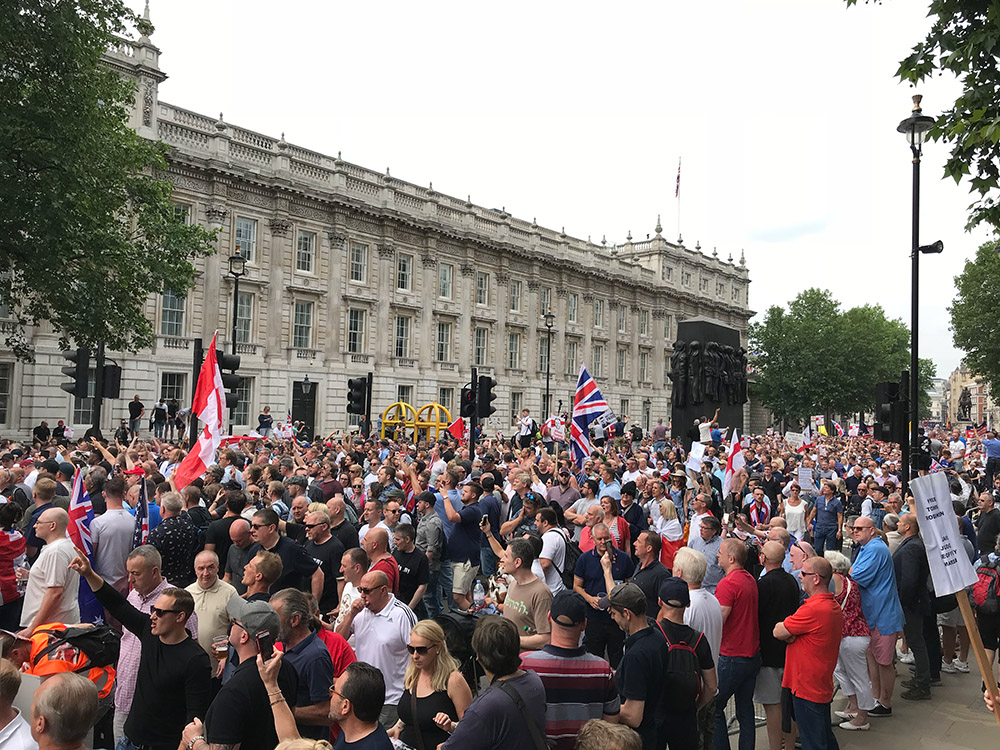
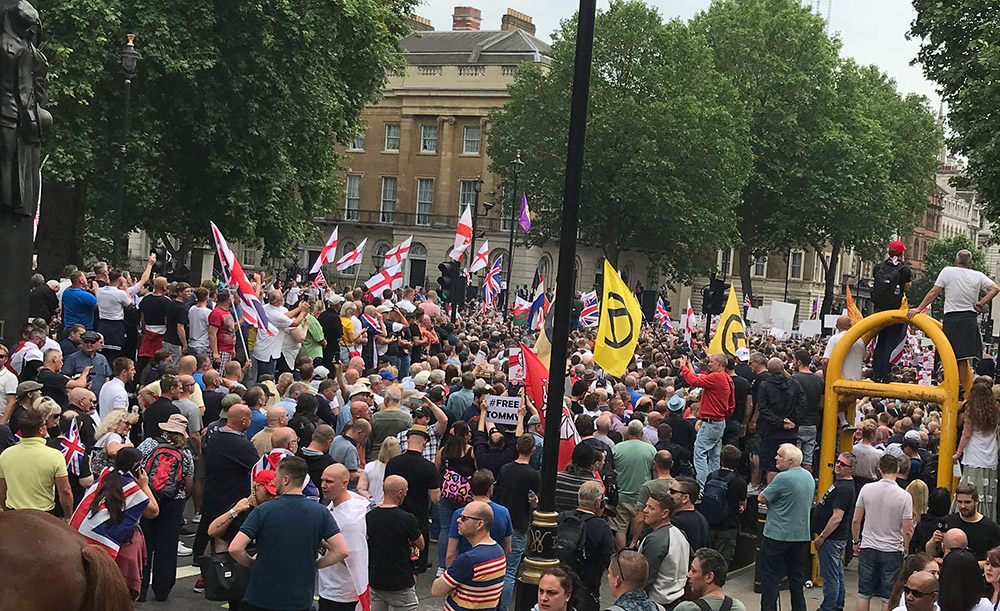
There was a “Don’t tread on me” snake flag, a favourite motif of the US “alt-right”.
The small group of GI members turned up in uniform branded black polo shirts, while another small group wore the black polo shirts with yellow details favoured by the all-male “Western chauvinist” Proud Boys group in the US.
Notably, international supporters had also brought flags – including those of the far right Wolnosc (Liberty) party of Poland and national flags from the US, New Zealand and the Netherlands.
Tommy Robinson is the figurehead of this movement. His jailing has only reinforced his popularity and boosted his profile, across Britain and internationally. His name was chanted throughout the event (see video below).
Robinson, once a member of the fascist British National Party, was a founding member and leader of the EDL and is hero-worshipped by the grassroots of this new developing far right movement. He has recently allied himself publicly with the hardcore fascist ideologues of GI.
Robinson’s “Day for Freedom”, a festival of hate outside Downing Street staged on 6 May was a 5,000-strong rally including a feeder march of up to 3,000 called by the Democratic Football Lads Alliance (DFLA), the far right organisation made up of football hooligan firms.
He has built up a very significant alternative media presence, with over 883,000 Facebook followers. So far 1.2m people have watched the live video of the protest streamed on his Facebook page.
There is a growing international dynamic to his status: on Saturday there were international “Free Tommy” solidarity protests in Belfast, New York, Brussels, Chicago, Wellington, Tel Aviv, Toronto and elsewhere.
This movement is growing at speed, but it would be a mistake to think it is shallow. Its roots are deep and its core ideas have been swilling around the British political landscape for nearly two decades.
Similarities
There were a number of similarities between May’s “Day for Freedom” rally and the “Free Tommy” demo.
At both rallies a number of speakers attempted to develop the key political themes of far right in Europe and the US. As with the Day for Freedom demo, this was a very ideological event. There was even a bookstall in Trafalgar Square that was selling copies of Tommy Robinson’s book and GI materials.
Similarities between the two events could also be seen in the main themes of the speeches, which promoted vile Islamophobia and racism directed at immigrants. But notably, they also centred on opposition to “the elite”, challenging the government, the state, the centres of power.
Several speakers also directed hatred towards the Labour Party and antifascists. Sadiq Khan, the Labour Mayor of London, who is Muslim, was a particular target of racist abuse and conspiracy-based scapegoating, loudly cheered by the thousands of attendees.
The rally was compered by Raheen Kassam, who until a couple of weeks ago was London chief of the far right Breitbart website. He is a leading figure in the far right in Britain and has personal connections with US president Donald Trump.
His remarks gave an insight into the direction he wants to see this movement go. He spoke about people taking “their countries back” in Italy, Poland and Hungary and the need to build a similar movement in Britain.
Kassam also quoted Enoch Powell saying, “To see and not speak would be the greatest betrayal.” Powell’s racist agenda has shaped British far right politics in Britain for half a century and is a touchstone figure for racists and fascists. Kassam wants to rehabilitate Powell and has just published a biography, Enoch was right: ‘Rivers of Blood’ 50 years on.
Steve Bannon, US president Donald Trump’s former adviser and former executive chair of Breitbart sent a message of support for Robinson to be read out at the demo.
Over the last few months Bannon has visited Europe on a number of occasions, speaking in France, Hungary, Italy and the Czech republic. Earlier this year, Bannon spoke at a meeting with the fascist Front National leader Marine Le Pen, telling the audience: “Let them call you racist, xenophobes, nativists, homophobes, misogynists – wear it as a badge of honour!”
He is acting as an outrider for Donald Trump and promoting a vicious racist agenda. His interventions are directed at pulling together a far right international, across Europe and America – and the process works both ways, with a cross-fertilisation of ideology and organisation.
Tommy Robinson also received a message of support from Louis Aliot, deputy leader of the fascistFront National in France and partner of its leader, Marine Le Pen.
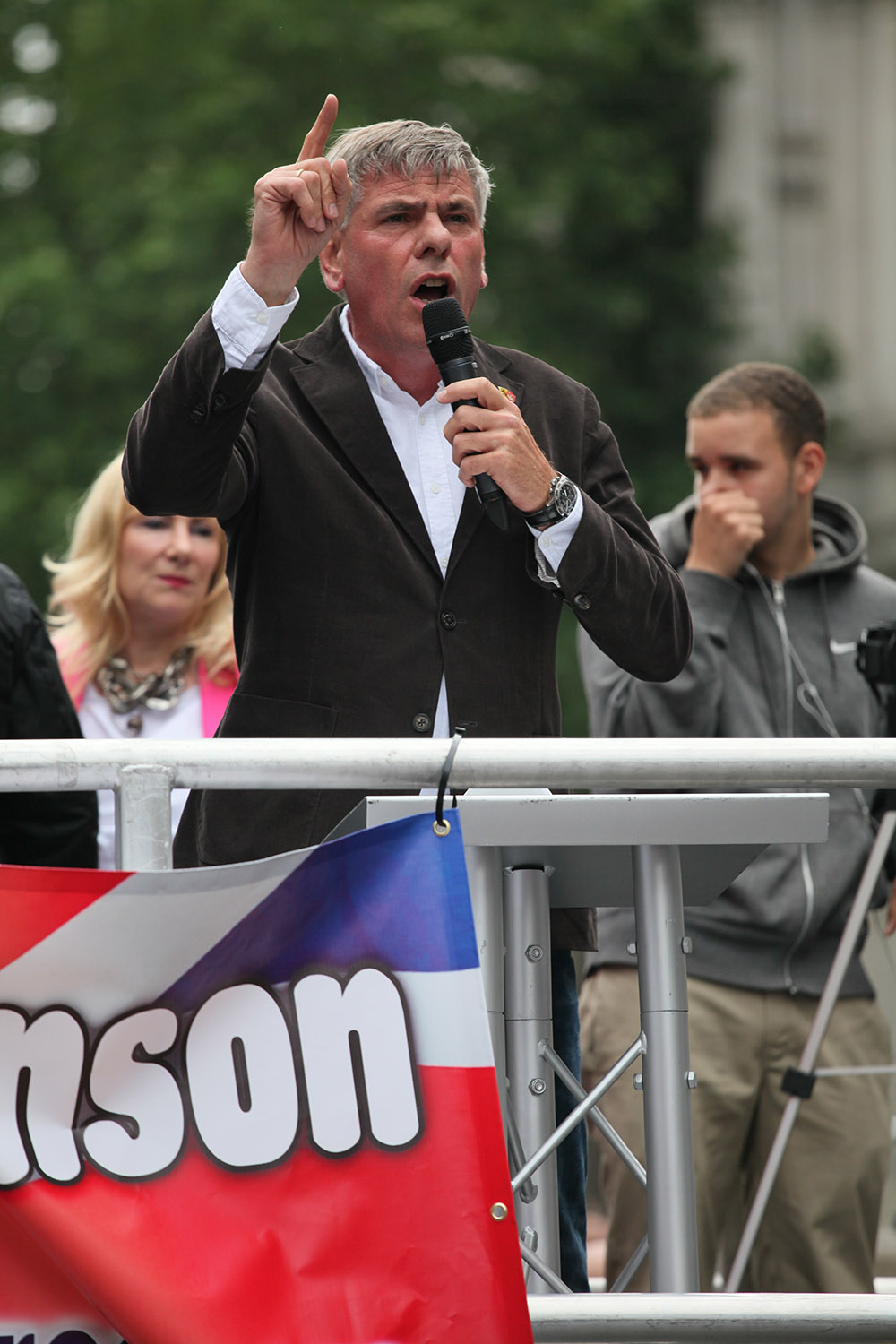
The speeches were kicked off by Filip Dewinter, an MP in Belgium and a leading member of the fascist Vlaams Belang (formerly the Vlaams Blok). Dewinter has been a guest speaker at gatherings of Belgians who fought alongside the Nazis as SS soldiers in World War Two and has also laid flowers at the graves of Flemish SS collaborators.
In the late 1990s he called for the wholesale deportations of unemployed migrants and the ending of political asylum. He has also called for a “white Europe”.
Dewinter began the rally on an explicitly racist note, urging the crowd “against Islamisation, against multiculturalism”. He spoke of the “failure of multiculturalism” and declared, to huge applause, that “the enemy… is Islam.”
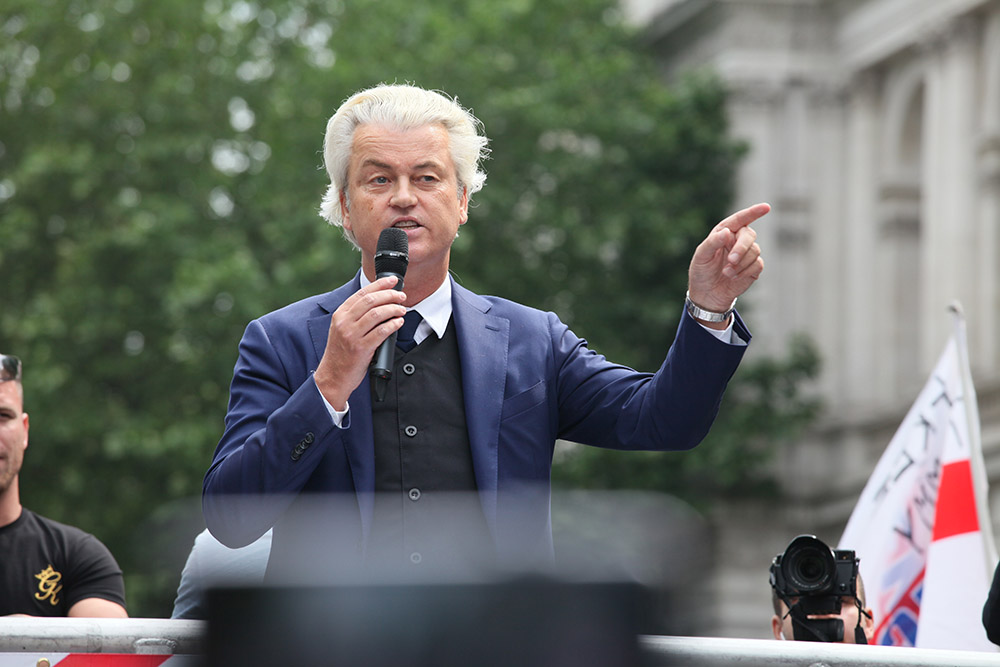
But the star speaker of the day was Geert Wilders, leader of the racist populist Party for Freedom (PVV) in the Netherlands. The party won 20 seats out of 150 in the 2017 general election and is the second largest party in parliament. Wilders’ speech was full of Churchillian references and attacks on British Asian politicians.
Wilders’ presence was important because he is a key figure in bringing together the far right across Europe, and is central to alliances taking in France’s fascist Front National, Italy’s racist Lega, Austria’s FPÖ and other far right parties.
He ensured massive coverage for Robinson in the Netherlands by claiming him as a “working class hero” – despite Robinson’s longstanding business interests.
Interspersed with some of the leading figures of the far right in Europe and the US were some home-grown racists. UKIP leader Gerard Batten spoke in defence of Robinson and urged people to join and vote UKIP.
Anne Marie Waters spoke late in the two-hour rally. She urged the crowds to join her Islamophobic splinter party For Britain and support her byelection campaign in Lewisham East on 14 June.
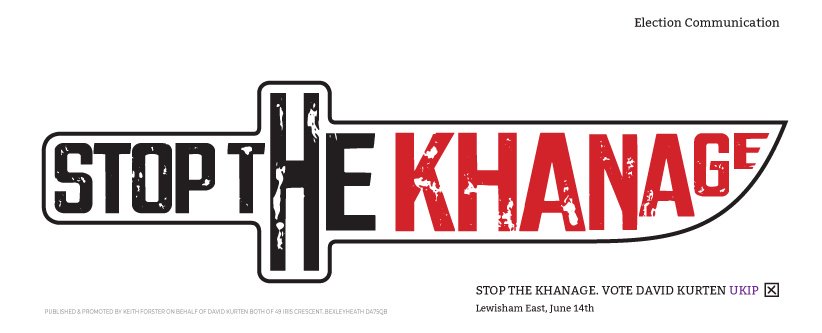
Both UKIP and For Britain are contesting the seat and their campaigns are degenerating deeper into the racist gutter. UKIP have produced an election leaflet that depicts a dagger with the words “Stop the Khanage” written on it – a vicious attempt to associate knife crime with London’s mayor Sadiq Khan and, by extension, with Muslims.
Former UKIP and now independent MEP, Janice Atkinson, also spoke. She is a member of the Europe of Nations and Freedom European Parliamentary Group. This is a far right platform supported by the FN, PVV, FPÖ, Vlaams Belang and Italy’s Lega.
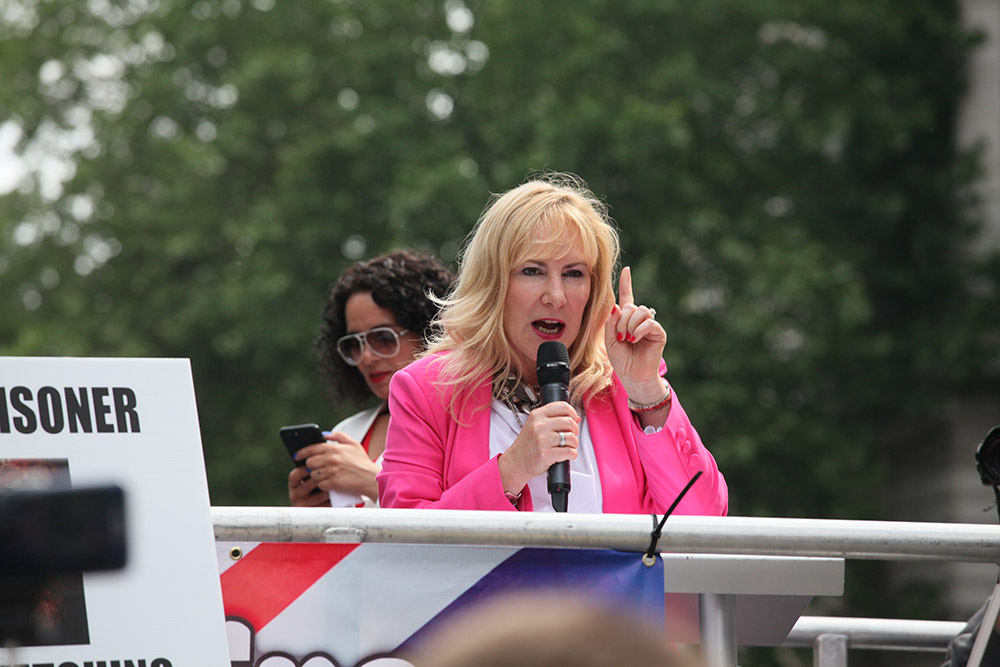
Atkinson is a key lynchpin between the European far right and the emerging British far right street movement. On 5 June she hosted a meeting at the European Parliament with guest speakers Lee Williams from the DFLA and Richard Inman of Veterans Against Terrorism (which works closely with the football hooligans’ group).
Also in attendance that day was Kevin Carroll, Robinson’s cousin, founding member and deputy leader of the EDL. He is also a former BNP supporter who in 2007 signed nomination papers for BNP election candidate Robert Sherratt in Luton. Carroll was the final speaker at the “Free Tommy” Rally.
Differences
But while the speakers at the “Free Tommy” rally echoed many of the themes of the “Day for Freedom” event, there were some important differences between the two demonstrations.
First and foremost this protest was three times bigger than the “Day of Freedom”.
Second, the DFLA was not an organised component of the “Free Tommy” protest. Of course many DFLA supporters were present, but the leadership of the DFLA was at best lukewarm to the event and did not mobilise for it.
They want to keep hold of their chunk of the movement and maintain independence from Tommy Robinson. And, in turn, Robinson wants to maintain his independence from them.
While the Day for Freedom event was called by Robinson himself, the initial call for the “Free Tommy” protest on Saturday – and the snap demos in Leeds and London that preceded it – came from far less well known individuals, albeit with serious fascist connections, as we revealed here.
The third difference was the tone of the “Free Tommy” rally. Unlike the “Day of Freedom” event it was not a festival. There were no “comedians” cracking “jokes” or drag queens singing cheesy cover songs this time.
The speeches were more aggressive in tone, more openly racist and ultranationalist.
And both the speeches and messages of support came from serious figures of the far right and fascist movement across Europe and the US. There was no soft underbelly.
That harder edge soon manifested itself in violence.
Thugs attempted to attack the Stand up to Racism counter demonstration, then – while the rally speeches continued outside Downing Street – hundreds of far right thugs began to throw missiles and fight the police at the top of Whitehall near Trafalgar Square (see video below).
The attack on the police was not a reaction to heavy policing – they had in fact taken a light touch approach to the event. Instead it had a noticeably political edge, with the Tommy Robinson supporters chanting “Shame on you” and “You let your country down”. Groups of demonstrators chased the police down side streets.
A key question is, what kind of movement is this new far right?
At the moment the revival of the far right in Britain is taking place on the streets. It is a very broad movement, one that spans the full spectrum of the far right – at the most extreme are the hardcore nazis and fascist groups, but there are also racist populists such as UKIP and the ultranationalist and racist football firms.
These different forces have united around a number of issues but the major players are competing with each other too.
Fluid
It is a very fluid movement, with different groups and individuals emerging and fighting for influence. It makes sense to consider Tommy Robinson supporters and organisations such as the DFLA as elements in the same movement, operating within it. At different times different elements will come to the fore.
This is why looking at each protest in isolation is not a fruitful way to understand the trajectory of this new movement. There are numerous reasons why some demos will be bigger or smaller than others. The key task is to assess if this movement is going forward or backward – and by any measure it is growing.
It is also important to note that at present, leading figures and groups have influence but not control over their followers. We have seen the tensions between leaders and footsoldiers in the internal battles for control of the Football Lads Alliance.
Autonomy
Saturday’s events also showed how demonstrators have a large measure of autonomy, outside of official calls. The early chanting and flag display in Trafalgar Square was self-organised by its participants, complete with smoke and flares.
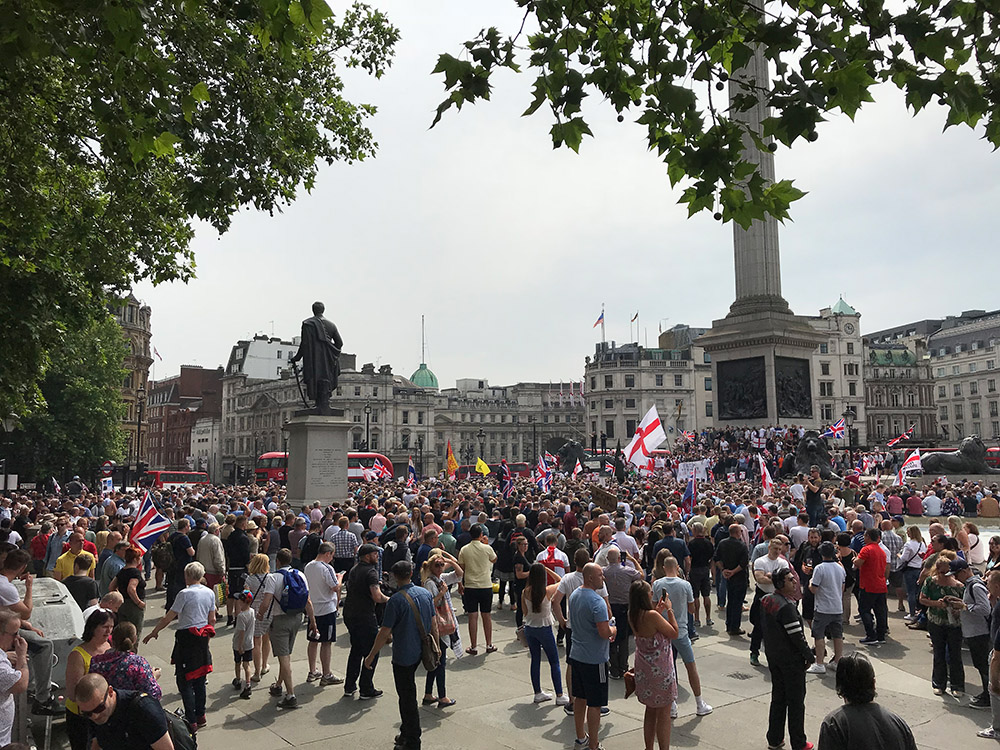
When the marchers reached the rally point at Downing Street, organisers had to urge the crowd not to throw things, surge forward or set off more flares. And the fighting against police, with hundreds of demonstrators involved, began at some distance from the rally, while the speeches were still in progress.
In what direction will the new far right movement develop? At present, it is too early to try to predict – the growing movement has options.
Streets
At present the movement is focused on the streets, with larger and larger numbers turning out and the ability to call sizeable snap demos with very little notice.
Historically fascist and far right movements have attempted to march in areas with large numbers of people from ethnic minority groups. Mosley and his supporters targeted the Jewish community in east London in the 1930s. The EDL held provocative marches in areas with large Muslim communities.
This is not happening at the moment. There are two possible explanations for this. The first maybe a conscious decision not to repeat the strategy of the EDL. Its idea of local marches in areas with large Muslim populations led to its demise as antifascists and local people were able to mobilise huge numbers to defeat it in key east London locations and hold it back in Bolton.
The second is a political difference with past movements. Racism and Islamophobia are a key mobilising issues for the new right, but it also believes that its time has come, and the so-called “liberal elites” are finished. This movement is now taking aim at the centres of power. Last week’s Leeds protest shows that given the opportunity these groups will target Muslim areas.
And worryingly the new movement has shown its ability to “normalise” their marches and hold mass rallies in Whitehall, aiming at the seats of parliamentary democracy and state power – this is something the far right have never been able to do before.
In this way, the far right is seizing the traditional ground of the labour movement and the left.
The new far right movement is sustained by significant international support and fed by a huge network of far right social media ideologues and outlets. While most of the participants are broadly far right and racist, hardcore fascist groups and ideologues are building their influence within the wider movement.
Electoral
As yet, there is no serious electoral dimension of the new movement – although many of the key political figures would like to see one. UKIP’s Gerard Batten is keen to rebuild UKIP on the back of the street movement, while Raheem Kassam announced his departure from Breitbart at the end of May amid hints of a challenge in the London mayoral elections.
The combination of an electoral wing and a street fighting wing is a dangerous one – this is the classic fascist strategy pioneered by Hitler and Mussolini.
And there are more recent examples of how the far right can move between electoral and street movement routes.
Street movements in Germany and Hungary have prompted the development of electoral parties such as the far right AfD in Germany, which grew substantially out of the racist Pegida movement, and the nazi Jobbik in Hungary, which retains links with a paramilitary wing.
In 2006, the far right Fidesz party in Hungary – an existing electoral party – made a rapid turn towards organising within the mass protests against the then social democratic government to compensate for its poor performance electorally. It was its role in this movement that cemented Fidesz’s position as Hungary’s biggest party. This is the strategy being adopted by UKIP today.
Whether the far right in Britain turns back towards electoralism or not, one thing is clear. It has put more bodies on the street than any other far right or fascist movement.
At its height Oswald Mosley’s BUF was able to hold indoor rallies of 10,000 in Olympia and the Royal Albert Hall. And the EDL was able to put upwards of 2,000 on the streets in towns such as Luton – its home base – and in Stoke and Dudley, where their protests degenerated into violent rampages.
Saturday’s demonstration was on a different scale.
Over the coming weeks, Robinson’s campaign will try to ratchet up the pressure to free him from jail – they have called a further London demo for 14 July, the day after Donald Trump’s planned visit to Britain. We can also expect further snap demos, mobilisations by the DFLA and the planned march by the UK Freedom Movement umbrella group on 23 June.
The “Free Tommy” demo has not come out of nowhere, but it shows how far and how fast the far right can grow without serious mass opposition.
Almost exactly a year ago, we highlighted a march of several thousand, called by Tommy Robinson in Manchester. Two weeks later, we produced our eyewitness report on the Football Lads Alliance’s first demo, which was also very large.
The two marches were a warning. But we also looked back at how the EDL was beaten, through a massive campaign of information to expose the racist thugs and the fascists in their midst and then mass mobilisations to block and demoralise them on the streets.
The campaign against the EDL left as its legacy an important lesson for antifascists and antiracists today. And while the far right has moved forward at frightening pace, they can still be countered. It is not too late.
Thanks to Nick Ullmann for additional photographs
Since this article was written the FLA and DFLA have announced that they are reuniting.
